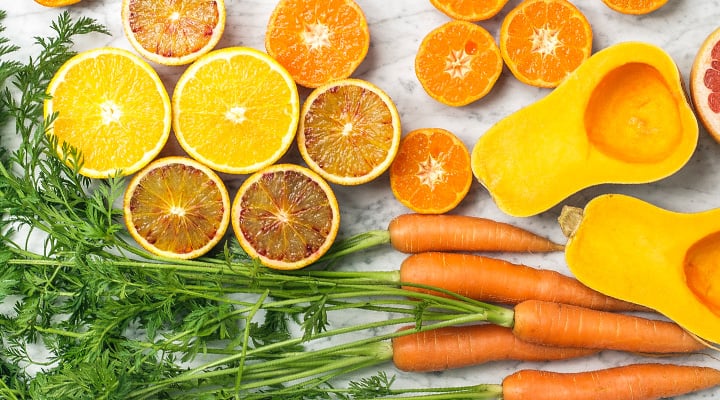
Carotenoid Tan: Natural Glow Without the Sun
Published: June 2024
The tanning bed increases your risk of skin cancer. Spray tans are expensive. At-home sunless tanners are just plain messy. And while being in the sun all day may give you the vitamin D your body needs, laying out without sunscreen is more likely to cause sunburn, wrinkles and irritated skin than leave you with a natural glow. It's no wonder people are talking about the "carrot tan."
This phenomenon made famous by TikTok, also known as a "carotenoid tan" (though medical professionals prefer the terms carotenoderma or carotenemia), occurs from eating large amounts of carrots and other orange- and yellow-colored produce.
At this point, you must be wondering: Can eating more carrots actually give you a natural tan? Or, as Bugs Bunny would say, "What's up, Doc?" You're not wrong to question the logic, but what the science says may surprise you.
Get to know carotenoids
First, you need to understand why carrots are the secret ingredient. They're famously rich in carotenoids. Carotenoids are a class of naturally occurring pigments in the yellow, orange and red families and are produced by plants, algae and photosynthetic bacteria.
Experts say around 1200 carotenoids have been identified, though only about 40-50 are present in the foods we eat. But that doesn't mean they're hard to get! The most common carotenoids found in the human diet are:
- α-carotene (alpha-carotene)
- β-carotene (beta-carotene)
- Lycopene
- β-cryptoxanthin
- Lutein
- Zeaxanthin
Pro-tip: Although many people associate carotenoids with vitamin A, the two are not the same. Certain carotenoids, like α-carotene, β-carotene and β-cryptoxanthin, can convert to vitamin A (called provitamin A carotenoids). On the other hand, preformed vitamin A, such as retinol, is found in animal products and readily available to the body. Be mindful of high preformed vitamin A consumption though—too much can be toxic to the body.
Do carotenoids make you tan?
Now, back to the original question: Can carotenoids give you a natural tan? The short answer: Yes, but it's not your typical tan.
When you think of a suntan, you probably envision a healthy glow a couple of shades darker than your natural skin. That's because exposing skin to ultraviolet (UV) light stimulates the production of melanin—a group of brown pigments that provide rich color to your skin, hair and eyes.
Carotenoids, on the other hand, are molecules with a yellow, orange or red hue. Multiple studies have looked into the effects of carotenoids on skin color, and the results are fascinating. Indeed, higher consumption of carotenoid-rich fruits and vegetables leads to "increased skin yellowness"—what many consider to be a desirable enhancement—and one that's relatively easy to obtain.
This skin change is mostly associated with consumption of alpha- and beta-carotene, in particular, with one study singling out apples, pears, mangoes, beans, lentils, spinach, broccoli, corn and baked beans for contributing "a significant proportion of the variation in skin yellowness." So, while carotenoids can influence the color of your skin, the effect is more of a golden yellow than a golden brown.
It's also important to note that not all skin tones will be influenced by carotenoids in the same way. The yellowness likely won't be as pronounced for people with darker skin as it is in people with lighter skin. That doesn't mean people with darker skin tones won't see a difference. Areas of their body with lighter pigmentation and less melanin, such as the palm of the hands, will still have a noticeable change in hue.
How long does it take to get a carotenoid tan?
A carotenoid tan develops from high blood concentrations of beta-carotene. The time it takes for blood concentrations to elevate varies from person to person, because everyone metabolizes nutrients a little differently.
Of course, we can turn to the research to get an estimated timeframe. In one study, increasing fruit and vegetable consumption for six weeks was enough time for the Caucasian participants to see measurable changes in skin redness and yellowness.
In a separate study, skin color changes were monitored in a sample of young adult Asian participants. They were randomly assigned to either consume a multi-ingredient fruit smoothie or mineral water every day for six weeks.
After only four weeks, the intervention group (the group consuming fruit smoothies) had a large incremental increase in skin yellowness and a slight change to skin redness. The mix of ingredients in the smoothie provided an average daily dose of 25.38 milligrams of carotenoids, with 80% from β-carotene, 15% from α-carotene and 5% from lycopene.
All that to say, based on current research, the best estimate is to expect a carotenoid tan to develop in around four to six weeks with continuous high carotenoid consumption.
Is it “carrot tan” or a disease?
Carotenoderma is a yellow-orange pigmentation that is concentrated in the palms of the hands, soles of the feet and smile lines of the face, and it's what people loading up on carrots are striving for. However, certain diseases can cause similar skin changes, including melanoma, kidney disease, jaundice and hypothyroidism.
How can you tell the difference between carotenoderma and abnormal skin color or discoloration? Look for other key signs and symptoms. Jaundice, for instance, can turn the whites of a person's eyes a noticeable yellow color. And hypothyroidism usually comes with unintentional weight gain, sensitivity to cold temperatures, irritability and thinning hair.
Of course, if there's any chance you've unknowingly increased your beta-carotene intake, you might just be experiencing that natural carrot tan, after all! If you're not sure, the best course of action is to speak with your healthcare provider.
What are the benefits of carotenoids?
Aside from influencing your skin, carotenoids play a major role in protecting the immune system, filtering blue light for eye health and supporting brain function.
Antioxidant protection—
Carotenoids are well-known antioxidants. They help neutralize free radicals before they can cause harm to healthy cells.Blue-light filtering—
Carotenoids have the unique ability to absorb blue light. This particular superpower is associated with lutein, zeaxanthin and meso-zeaxanthin. A high concentration of these carotenoids at the center of the eye's retina (macula) can lead to the absorption of up to 90% of blue light.Immune system defense—
Vitamin A is an essential nutrient for healthy immune system function. Therefore, the provitamin A carotenoids (α-carotene, β-carotene and β-cryptoxanthin) are indirectly related to immune health. A few clinical trials conducted on men concluded that taking β-carotene can improve biomarkers of immune function.Cognitive boost—
The carotenoid lutein accumulates in the brain and helps with cognition, which may help explain why brain lutein concentrations are significantly lower in those experiencing mild cognitive impairment compared to those with normal cognitive function. Research suggests taking lutein and zeaxanthin together can actually improve memory and overall cognitive performance.Disease prevention—
Carotenoids have been studied for their ability to prevent various diseases, including several different types of cancer, age-related macular degeneration (AMD), diabetic retinopathy, cataracts, cardiovascular disease and osteoporosis. The level of evidence varies depending on the condition in question, but generally speaking, the carotenoids with the most clinical research are beta-carotene, lycopene, lutein and zeaxanthin.What we do know for certain is that a diet full of nutrient-dense fruits and vegetables—including those rich in carotenoids—can help reduce your risk of developing serious health conditions. So make sure that carotenoids are part of your daily routine—your body will thank you!
What happens if you have too many carotenoids?
As we mentioned earlier, high dietary intake of preformed vitamin A can cause moderate to severe toxicity symptoms. Because vitamin A is a fat-soluble vitamin, it is harder for your body to get rid of any excess.
The good news is carotenoids are a provitamin A and are not associated with the same health hazards. The worst thing that can happen from consuming too many carotenoid is you get a carotenoid tan. Rest assured, carotenoid tans are harmless and temporary. By simply reducing your carotenoid intake, your skin color will return to normal. So, go ahead and eat the rainbow. There is no reason fruits and vegetables should not be a part of your daily diet—and the more colorful, the better!
Where are carotenoids found?
Realistically, any orange-, red- or yellow-hued fruits and vegetables will be rich sources of carotenoids. Pumpkins, large carrots, squash, tomatoes, red peppers and oranges are the most common nutritional sources. Leafy greens, like kale and spinach, are also surprisingly good sources of carotenoids. Remember, carotenoids are naturally occurring pigments, produced by plants, algae and photosynthetic bacteria. (No, that does not mean you need to start eating ocean grass or bacteria to get a carotenoid tan.)
Of course, carotenoids are found in capsule and softgel forms. Dietary intake of carotenoids in these forms can be an easy way to ensure you are getting enough of these valuable phytonutrients—and they may be more efficiently absorbed than from food sources.
Can carotenoids replace sun exposure?
While carotenoids may be able to give your skin a beautiful glow, they can't replace the important benefits that can come with sun exposure (like helping us synthesize vitamin D, a fat-soluble vitamin that plays an important role in overall health).
Pro-tip: It's equally as important to limit your time in the sun when it's at its peak and to use sun protection especially when you're outside for lengthy periods.
So whether you're staying out of the sun for one reason or another, or you're experiencing limitations like your geographic location, you may want to check your vitamin D and other blood levels periodically through lab testing to make sure your health is in a good place.
References
- Coetzee V, et al. "Effect of beta-carotene supplementation on African skin." J Biomed Opt. February 2014. https://pubmed.ncbi.nlm.nih.gov/24525826/
- Coyle DH, et al. "Intake of specific types of fruit and vegetables is associated with higher levels of skin yellowness in young women: A cross-sectional study." Nutr Res. August 2018. https://pubmed.ncbi.nlm.nih.gov/30055771/
- Maoka, Takashi. "Carotenoids as natural functional pigments." J Nat Med. 2020. https://www.ncbi.nlm.nih.gov/pmc/articles/PMC6949322/
- Tan KW, et al. "Daily Consumption of a Fruit and Vegetable Smoothie Alters Facial Skin Color." PLoS One. July 2015. https://pubmed.ncbi.nlm.nih.gov/26186449/
- Whitehead RD, et al. "You are what you eat: within-subject increases in fruit and vegetable consumption confer beneficial skin-color changes." PLoS One. July 2012. https://pubmed.ncbi.nlm.nih.gov/22412966/
- "Carotenoids." Data on file.
Always be in the know!
Access the latest deals, wellness news, expert health tips & more!











